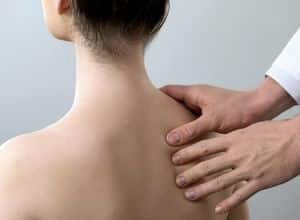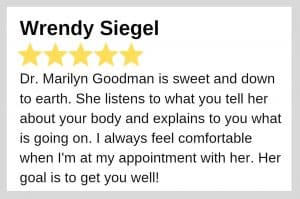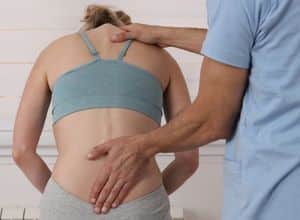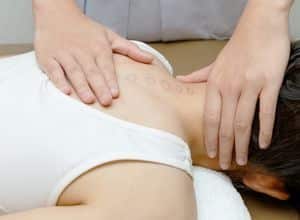If you’ve been diagnosed with scoliosis, you might be thinking about going to a scoliosis chiropractor for treatments to help straighten your spine. That may be particularly true if you’ve begun to suffer from complications of scoliosis, like back or shoulder pain.
What Is Scoliosis?
Scoliosis is an irregular sideways curve in the spine that impacts at least 3% of the population. The abnormal spinal curve can occur anywhere in the spine, most commonly occurring in the mid-back (thoracic) spine.
In a normal spine, the vertebrae are stacked vertically on top of each other, like a stack of blocks. However, in scoliosis, the vertebrae tilt to the side, making the spine curve in a way it is not designed to do.

Several scoliosis subtypes exist, including:
Idiopathic scoliosis: It is the most common scoliosis type, in which the cause is unknown.
Neuromuscular scoliosis: In these cases, scoliosis is caused by underlying neuromuscular conditions like cerebral palsy, muscular dystrophy, spina bifida, or polio
Congenital scoliosis is present at birth and occurs when a baby’s ribs or spine do not form properly.
Often, scoliosis has no symptoms. For this reason, a person may not be aware they have scoliosis until a doctor tells them about it. Unfortunately, even if the person doesn’t have symptoms, the spinal curvatures in scoliosis may worsen over time if left untreated. That can lead to complications like:
- Back or shoulder pain
- Weakness in the spine
- Muscle spasms in the back
- Uneven hips or shoulders
- Breathing problems
- Spinal or nerve damage
- Spinal fluid leakage
Does Scoliosis Worsen With Age?

Scoliosis can worsen with age and over time, especially without treatment. About 40% of adult scoliosis patients experience worsening their condition with time.
As a person ages, they might develop degenerative scoliosis. In this condition, the spinal curvature is often in the lower back.
Spinal stenosis, a spinal canal narrowing, often occurs alongside degenerative scoliosis. A person with degenerative scoliosis may experience gradual pain, especially with activity.
Moreover, degenerative disorders such as osteoporosis can cause the bones in the spine to lose their normal shape. The body must compensate by creating lateral curves in the spine to ensure that the head remains level. If the cause of the bending isn’t addressed, there may be severe consequences, such as heart and lung problems.
Can Scoliosis Be Cured?
Scoliosis is a treatable condition. However, it is not curable. Unlike other chronic health conditions like high blood pressure or diabetes, scoliosis can be managed. Chiropractic care is an alternative to traditional medical scoliosis treatments, including bulky spinal braces or spinal surgery.

Typically, under 20 degrees of curvature can be managed conservatively with chiropractic or monitored. 20-40 degrees can combine conservative care (chiropractic) and bracing or other interventional treatments, including massage therapy. Advanced scoliosis over 40 degrees may require surgery that uses Harrington rods to straighten the curvature.
What Tests are Used to Diagnose Scoliosis?
If someone thinks they have scoliosis, see your doctor for an examination. Your doctor would ask questions, including if there is any family history of scoliosis or if there’s been any pain, weakness, or other medical problems.
The physical examination involves looking at the spine’s curve from the front, sides, and back. The patient would be asked to undress from the waist up to see better any physical deformities, abnormal curves, or uneven waist. The patient would then bend over, trying to touch their toes. This position could make the curve more obvious.
Your doctor would also look at the body’s symmetry to see if the shoulders and hips are at a similar height, leaning to one side, or if there’s sideways curvature.
If your doctor thinks you have scoliosis, you may obtain X-rays of the back. If X-rays are obtained, they can make measurements from them to determine how large a spinal curve is present. That can help decide what treatment, if any, is necessary. You can compare measurements from future visits to see if the curve worsens.
Also, if there are any changes in the function of the nerves, they may order other imaging tests of the spine, including an MRI or CT scan, to look more closely at the bones and nerves of the spine.
What Happens When Scoliosis is Left Untreated?
If scoliosis and its cause are not checked, it could lead to severe, long-term consequences. Scoliosis is associated with neck, back, shoulder, and buttocks pain. It could lead to re-occurring injuries and has been linked to sciatica. It can cause diminished lung and heart capacity, painful menstruation, and physical disability in severe cases.
Can A Scoliosis Chiropractor Straighten Your Spine?
Studies have shown that a scoliosis chiropractor could help alleviate pain, spinal curvature, and disability from scoliosis in adults over the long term. That is especially true when chiropractic care is combined with other scoliosis treatments like exercise and certain stretches.
Scoliosis can be managed by combining spinal realignment from chiropractic care with muscle-strengthening exercises and stretches to support your new spinal alignment.

Studies in adolescents with scoliosis have also provided promising results with chiropractic care. That is especially true when chiropractic care has been combined with other treatments like nighttime bracing. Scoliosis chiropractors are conducting additional studies to help future treatments.
Chiropractic treatment for scoliosis involves regular adjustments using the hands or a device. The goal is to realign the bones, muscles, and joints. There are two types to pick from: traditional and scoliosis specific.
Traditional Chiropractic Treatment for Scoliosis
Traditional chiropractic procedure applies a general approach, the same as what the scoliosis chiropractor would do for any other patient experiencing back issues. However, traditional chiropractic treatment is unlikely to affect the Cobb angle if the chiropractor isn’t practiced in scoliosis and is familiar with its intricacies.
This method is only suggested for patients over 13 with very small Cobb angles of 20 degrees or less. The traditional procedure can be useful for relieving pain but not for physically straightening the Cobb angle in people with scoliosis.
Traditional chiropractors may aim to straighten the curve, mobilize the spine, and press down on the rib cage and spine while the patient lies on their stomach (often called “adjusting on the high side of the rainbow.”). Nevertheless, the irregular curve of the spine often develops to take the tension out of the nerves.
Pushing down on the spine doesn’t relieve this tension; it aggravates the nerves further. With scoliosis, the spine isn’t stuck, as it is with most other chiropractic problems, but rather it curves in the wrong direction. You couldn’t mobilize a scoliotic spine without also correcting and stabilizing it.
Scoliosis-Specific Chiropractic Treatment for Scoliosis
Scoliosis-specific chiropractic treatment for scoliosis doesn’t use the traditional guidelines to stabilize the curve. Scoliosis-specific adjustments are precise and gentle, aiming to correct the spine into a classic spinal curve gradually. This method could help people in all walks of life — people who have already had surgery and don’t want to get it again, people trying to avoid surgery, teenagers who do not want to wear a brace, and people with mild scoliosis, among others.
Most people consider scoliosis a sideways spine curve, but it’s a bit more complicated than that. A spinal column should have three curves:

- The cervical lordosis points forward in the neck.
- The thoracic kyphosis points backward in the middle of the back.
- The lumbar lordosis points forward in the low back.
Scoliosis forces the spine in another direction for one or more of these three natural curves.
Scoliosis patients are double-jointed in the neck. This hypermobility makes their joints unstable and puts them at a greater risk of injury and dislocation if not treated gently. There’s no turning or twisting of the neck in scoliosis-specific adjustments. Scoliosis-specific adjustments done by a scoliosis chiropractor utilize a precision mechanical adjusting instrument to adjust the neck and other body joints.
The first action to restoring the good curves in the spine is to recenter the head. While the patient is sitting up, and adjusting instrument delivers precise but gentle forces into the neck’s bones. This moves the neck into the perfect position. A scoliosis chiropractor might also perform adjustments on the back and hips based on the three-dimensional measurements of the spine determined from x-rays.
Numerous chiropractors claim to specialize in scoliosis when their knowledge is limited. It is important to start a conversation with your doctor and physical therapist to ensure you’re receiving care from a scoliosis chiropractor who practiced scoliosis. If your scoliosis chiropractor does not give you the results you want or adjust the treatment to yield them, it might be time for a new doctor.
Outside of the doctor’s office adjustments, one to two hours of exercise a day is needed to achieve the best results. Scoliosis exercises include strength training, and balance training, and, for severe cases of scoliosis, the scoliosis traction chair elongates the spine and uncoils the nerves with vibration. As your Cobb Angle decreases, you could decrease the exercises as well. However, you could never stop completely without the Cobb angle suffering.
To address scoliosis, you need to be your advocate. What matters to you? What makes the most sense for your unique lifestyle? What do you want to achieve? Maybe instead of focusing solely on improving the Cobb angle, you would rather address lifestyle issues or specific symptoms of scoliosis. It’s necessary to consult your doctor to empower yourself and take control of your spinal health.
If you seek care for scoliosis, it is important to choose a doctor who is an expert in scoliosis treatment. A doctor who is particularly credentialed in spinal biomechanics will be able to perform a biomechanical spine assessment and provide recommendations on how best to treat your condition.
The Best Scoliosis Chiropractor is Here for You
At HOT Chiropractic, our goal is to help our patients recover from back pain, neck pain, lack of mobility, joint issues, range of motion issues, and more—without prescription drugs. Our scoliosis chiropractors are trained to treat various health issues, including scoliosis.
We have a high level of commitment to helping our patients, and we believe in taking a holistic “whole-body” approach to your health. We don’t want to fix your pain temporarily—we want to determine and treat the root cause so you can enjoy an active and pain-free life.
FAQ
Can a scoliosis chiropractor fix scoliosis?
Good news! A scoliosis chiropractor can develop a drug-free and non-invasive scoliosis treatment plan that treats multiple symptoms. Although scoliosis chiropractors cannot straighten your spine completely, several studies have shown a significant improvement in pain, disability rating, and spine curvature, among those diagnosed with scoliosis.
Do chiropractors help scoliosis?
Yes, scoliosis chiropractors can identify scoliosis and advise a care plan that could help reduce or alleviate scoliosis pain. A lot of adults who have scoliosis find non-invasive and drug-free chiropractic treatments that could help minimize their pain by strengthening their body’s core and lessening the pressure on their nervous system.
How do chiropractors treat scoliosis?
Scoliosis chiropractors can treat scoliosis by combining spinal realignment from chiropractic treatments with muscle-strengthening stretches and exercises to help support your new spinal alignment.
